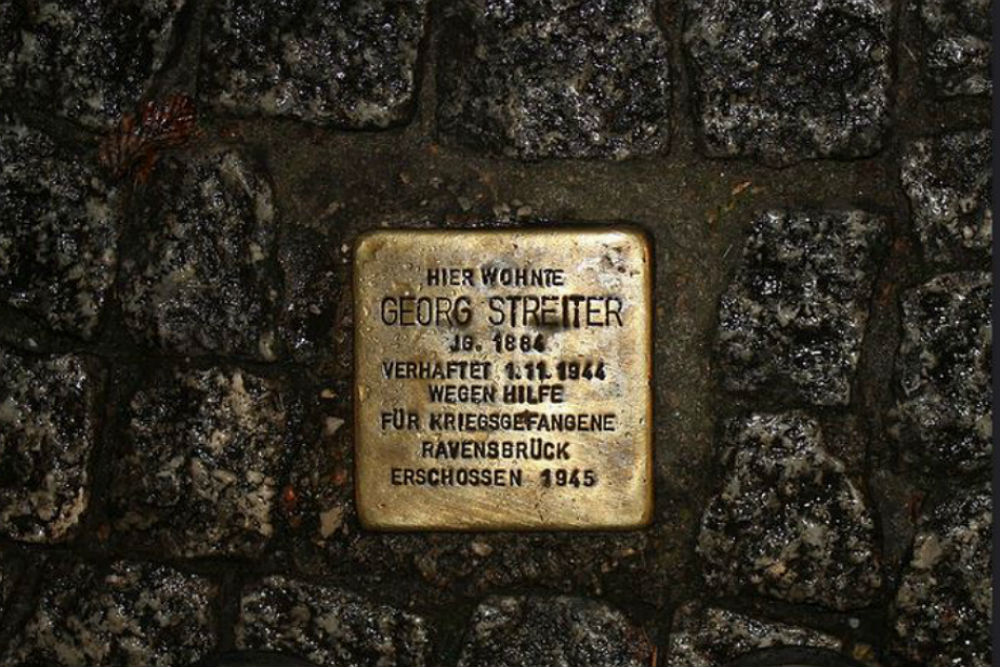Stumbling Stone Schönhauser Allee 130
This small brass memorial plaque (Stolperstein or stumbling stone) commemorates
* Georg Streiter, born 1884, arrested 1 November 1944, for helping prisoners of war, Ravensbruck, shot 1945.
Georg Streiter was born in Berlin. When he was still a teenager, he joined a Christian youth association for social work. He then became a male nurse. In April 1907, he married Elisabeth Mauss, also a nurse. Later that year, he was elected president of the Christian German nurses’ union and three years later wrote a paper on the situation of nurses in Germany. During World War I he was decorated for his work with the Red Cross in war zones. Then he was a founding member of the German People’s Party (DPV) in 1918. The next year he became a city councilor. In all his work, he tried to improve nursing and welfare work. However, his nursing welfare society, established in 1927, was banned by the Nazis five years later. In 1935, he returned to the Red Cross, and from 1940 he was responsible for Polish and French prisoners of war (POWs). In 1944, he was denounced and arrested in his Red Cross office, for reasons that are not clear -- illegally sending letters for POWs? sending medals to POWs?
It was after the war that his son learned from his father’s colleague that he had probably been shot in a concentration camp near Berlin. The Red Cross did not provide any information about his fate. One source states that in February 1945, he was taken to Ravensbrück, primarily a women’s camp, located 90 km north of Berlin. George Streiter, humanitarian and Nazi opponent, was executed at age 61.
"Stolpersteine" is an art project for Europe by Gunter Demnig to commemorate victims of National Socialism (Nazism). Stolpersteine (stumbling stones) are small, 10x10cm brass plaques placed in the pavement in front of the last voluntary residence of (mostly Jewish) victims who were murdered by the Nazis. Each plaque is engraved with the victim’s name, date of birth, and place (mostly a concentration camp) and date of death. By doing this, Gunter Demnig gives an individual memorial to each victim. One stone, one name, one person. He cites the Talmud: "A human being is forgotten only when his or her name is forgotten."
Do you have more information about this location? Inform us!
Source
Nearby
Museum
- Berliner Unterwelten (Air Raid Shelter Brunnenstraße) - Berlin
- Anne Frank Centre - Berlin
- Otto Weidt’s Workshop for the Blind - Berlin
Point of interest
Monument
- Memorial Werner Prochnow - Berlin-Prenzlauer Berg
- Memorial Käte Niederkirchner - Berlin-Prenzlauer Berg
- Memorial Heinrich Preuß - Berlin-Prenzlauer Berg
Cemetery
- Jewish Cemetery Schönhauser Allee - Berlin
- German War Graves Berlin-Wedding - Berlin-Wedding
- Mass Grave Germans Domfriedhof I - Berlin
Remembrance Stone
- Stumbling Stone Buchholzer Straße 4 - Berlin-Prenzlauer Berg
- Stumbling Stones Greifenhagener Straße 13 - Berlin-Prenzlauer Berg
- Stumbling Stones Stargarder Straße 6 - Berlin-Prenzlauer Berg





